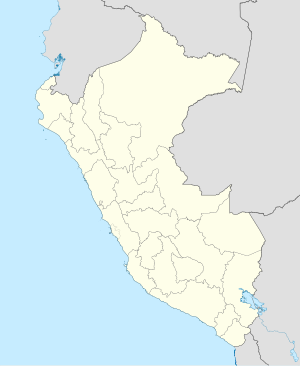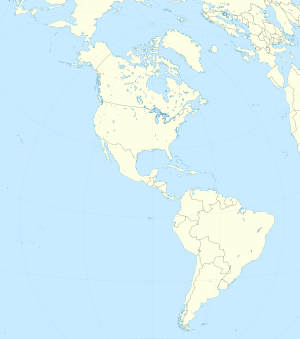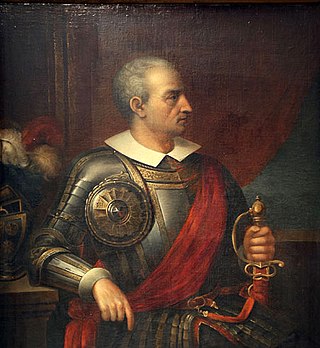
Diego de Almagro, also known as El Adelantado and El Viejo, was a Spanish conquistador known for his exploits in western South America. He participated with Francisco Pizarro in the Spanish conquest of Peru. While subduing the Inca Empire he laid the foundation for Quito and Trujillo as Spanish cities in present-day Ecuador and Peru, respectively. From Peru, Almagro led the first Spanish military expedition to central Chile. Back in Peru, a longstanding conflict with Pizarro over the control of the former Inca capital of Cuzco erupted into a civil war between the two bands of conquistadores. In the battle of Las Salinas in 1538, Almagro was defeated by the Pizarro brothers and months later he was executed.
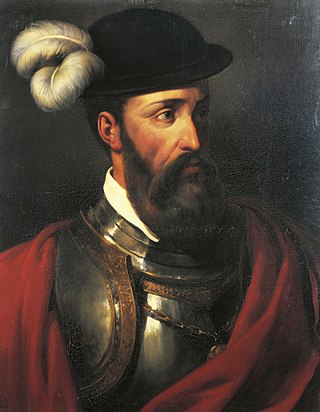
Francisco Pizarro, Marquess of the Atabillos was a Spanish conquistador, best known for his expeditions that led to the Spanish conquest of the Inca Empire.
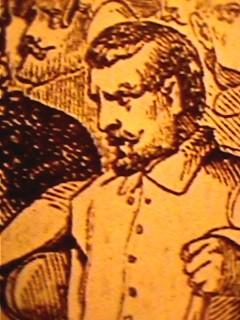
Gonzalo Pizarro y Alonso was a Spanish conquistador. He was the younger paternal half brother of Francisco Pizarro, who led the Spanish conquest of the Inca Empire. Pizarro was the illegitimate son of Gonzalo Pizarro y Rodríguez de Aguilar (1446–1522), who, as an infantry colonel, served under Gonzalo Fernández de Córdoba during the Italian Wars. He was also the younger paternal half brother of Hernándo Pizarro y de Vargas and the older paternal full brother of Juan Pizarro y Alonso.
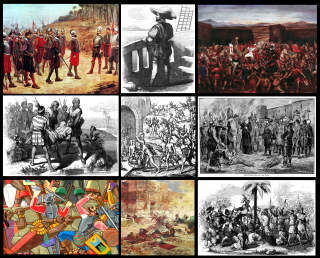
The Spanish conquest of the Inca Empire, also known as the Conquest of Peru, was one of the most important campaigns in the Spanish colonization of the Americas. After years of preliminary exploration and military skirmishes, 168 Spanish soldiers under conquistador Francisco Pizarro, along with his brothers in arms and their indigenous allies, captured the Sapa Inca Atahualpa in the 1532 Battle of Cajamarca. It was the first step in a long campaign that took decades of fighting but ended in Spanish victory in 1572 and colonization of the region as the Viceroyalty of Peru. The conquest of the Inca Empire, led to spin-off campaigns into present-day Chile and Colombia, as well as expeditions to the Amazon Basin and surrounding rainforest.

Manqu Inka Yupanki (Quechua) was the founder and monarch of the independent Neo-Inca State in Vilcabamba, although he was originally a puppet Inca Emperor installed by the Spaniards. He was also known as "Manco II" and "Manco Cápac II". He was one of the sons of Huayna Capac and a younger brother of Huascar.
Juan Pizarro y Alonso was a Spanish conquistador who accompanied his brothers Francisco, Gonzalo and Hernando Pizarro for the conquest of Peru in 1532.
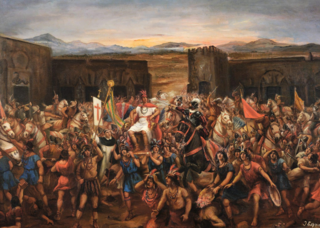
The Battle of Cajamarca also spelled Cajamalca was the ambush and seizure of the Inca ruler Atahualpa by a small Spanish force led by Francisco Pizarro, on November 16, 1532. The Spanish killed thousands of Atahualpa's counselors, commanders, and unarmed attendants in the great plaza of Cajamarca, and caused his armed host outside the town to flee. The capture of Atahualpa marked the opening stage of the conquest of the pre-Columbian civilization of Peru.

Francisco de Carvajal was a Spanish military officer, conquistador, and explorer remembered as "the demon of the Andes" due to his brutality and uncanny military skill in the Peruvian civil wars of the 16th century.
Hernando Pizarro y de Vargas was a Spanish conquistador and one of the Pizarro brothers who ruled over Peru.

Alonso de Alvarado Montaya González de Cevallos y Miranda (1500–1556) was a Spanish conquistador and knight of the Order of Santiago.
Diego de Almagro II, called El Mozo, was the son of Spanish conquistador Diego de Almagro and Ana Martínez, a native Panamanian Indian woman.
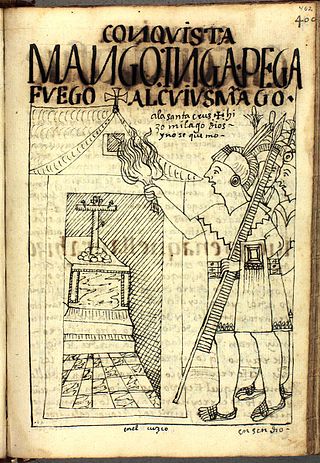
The 10-month siege of Cusco by the Inca army under the command of Sapa Inca Manco Inca Yupanqui started on 6 May 1536 and ended in March 1537. The city was held by a garrison of Spanish conquistadors and Indian auxiliaries led by Hernando Pizarro. The Incas hoped to restore their empire (1438–1533) with this action, but it was ultimately unsuccessful.
Rodrigo Orgóñez was a Spanish captain under Diego de Almagro, a conquistador known for his exploits in western South America.
The Battle of Ollantaytambo took place in January 1537, between the forces of Inca emperor Manco Inca and a Spanish expedition led by Hernando Pizarro during the Spanish conquest of Peru. A former ally of the Spaniards, Manco Inca rebelled in May 1536, and besieged a Spanish garrison in the city of Cusco. To end the stand-off, the besieged mounted a raid against the emperor's headquarters in the town of Ollantaytambo. The expedition, commanded by Hernando Pizarro, included 100 Spaniards and some 30,000 Indian auxiliaries against an Inca army more than 30,000 strong.

The Battle of Jaquijahuana was fought between the forces of Gonzalo Pizarro and Pedro de la Gasca, on April 9, 1548, during the Revolt of the Encomenderos by the Spanish conquistadores.
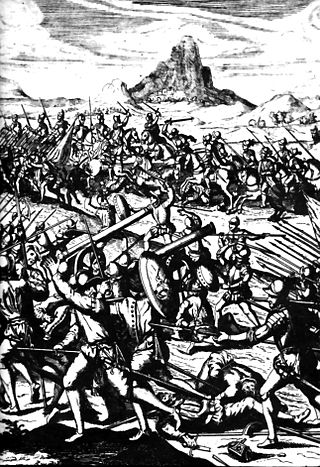
After the assassination of Francisco Pizarro, in retaliation for his father's execution in 1538, Diego de Almagro II, El Mozo, continued to press claims as the rightful ruler of Peru and as leader of his father's supporters. His claims were largely unsuccessful, however, as Pizarro was succeeded as governor by Cristóbal Vaca de Castro, despite claims from his brother Gonzalo Pizarro, whose claims to join arms against the Almagristas and "El Mozo" largely remained unanswered.
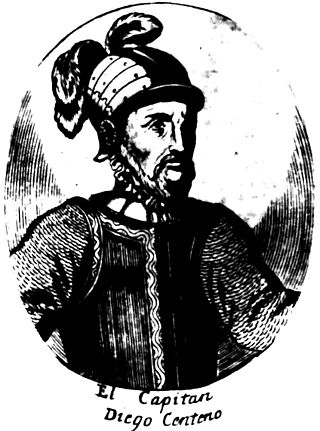
Diego Centeno was a Spanish conquistador. He arrived to South America and the recently conquered Inca Empire in 1534 at the age of 20, followed by, among others, Pedro de Alvarado, conqueror of Guatemala. In the ensuring battles between the Pizarro brothers and the Almagristas led by Diego de Almagro and, after his defeat and execution in 1538, by his son, Centeno took the party of Pizarro and New Castile. After the downfall of both parties, Diego fought with the Spanish royal forces of Pedro de la Gasca after the defeat and death of Blasco Núñez Vela on the hands of Gonzalo Pizarro. He was defeated in the battle of Huarina by Francisco de Carvajal but managed to reunite with de la Gasca and defeat the forces of Gonzalo and de Carvajal in the battle of Jaquijahuana.
The Battle of Abancay took place during the Spanish conquest of Peru. Alonso de Alvarado, sent by Francisco Pizarro to relieve the siege of Cusco, was camped at Jauja with five hundred men. He guarded the bridge and a ford on the Rio de Abancay, awaiting Almagro's men. However, the soldier Alvarado placed in command of the ford, Pedro de Lerma, deserted, allowing Almagro to capture Alvarado's force almost intact.
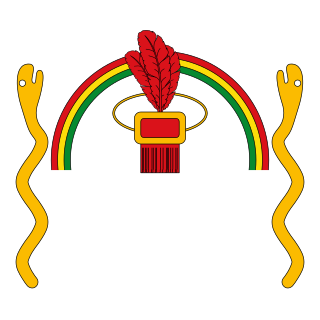
The Neo-Inca State, also known as the Neo-Inca state of Vilcabamba, was the Inca state established in 1537 at Vilcabamba by Manco Inca Yupanqui. It is considered a rump state of the Inca Empire (1438–1533), which collapsed after the Spanish conquest in the mid-1530s. The Neo-Inca State lasted until 1572, when the last Inca stronghold was conquered, and the last ruler, Túpac Amaru, was captured and executed, thus ending the political authority of the Inca state.
Gómez de Alvarado y Contreras was a Spanish conquistador and explorer. He was a member of the Alvarado family and the older brother of the famous conquistador Pedro de Alvarado.
MacQuarrie, K. (2008). The last days of the Incas. 1st Simon & Schuster trade pbk ed. New York, Simon & Schuster Paperbacks.
